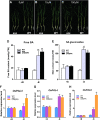APICAL SPIKELET ABORTION (ASA) Controls Apical Panicle Development in Rice by Regulating Salicylic Acid Biosynthesis
- PMID: 33719311
- PMCID: PMC7947001
- DOI: 10.3389/fpls.2021.636877
APICAL SPIKELET ABORTION (ASA) Controls Apical Panicle Development in Rice by Regulating Salicylic Acid Biosynthesis
Abstract
Panicle degradation causes severe yield reduction in rice. There are two main types of panicle degradation: apical spikelet abortion and basal degeneration. In this study, we isolated and characterized the apical panicle abortion mutant apical spikelet abortion (asa), which exhibits degeneration and defects in the apical spikelets. This mutant had a pleiotropic phenotype, characterized by reduced plant height, increased tiller number, and decreased pollen fertility. Map-based cloning revealed that OsASA encodes a boric acid channel protein that showed the highest expression in the inflorescence, peduncle, and anther. RNA-seq analysis of the asa mutant vs wild-type (WT) plants revealed that biological processes related to reactive oxygen species (ROS) homeostasis and salicylic acid (SA) metabolism were significantly affected. Furthermore, the asa mutants had an increased SA level and H2O2 accumulation in the young panicles compared to the WT plants. Moreover, the SA level and the expression of OsPAL3, OsPAL4, and OsPAL6 genes (related to SA biosynthesis) were significantly increased under boron-deficient conditions in the asa mutant and in OsASA-knockout plants. Collectively, these results suggest that the boron distribution maintained by OsASA is required for normal panicle development in a process that involves modulating ROS homeostasis and SA biosynthesis.
Keywords: Oryza sativa; anther; apical panicle abortion; reactive oxygen species; salicylic acid.
Copyright © 2021 Zhou, Shen, Cui, Liu, Zheng, Li, Wu, Fang, Liu, Tang, Yi, Zhao and Chen.
Conflict of interest statement
The authors declare that the research was conducted in the absence of any commercial or financial relationships that could be construed as a potential conflict of interest.
Figures








Similar articles
-
DEGENERATED PANICLE AND PARTIAL STERILITY 1 (DPS1) encodes a cystathionine β-synthase domain containing protein required for anther cuticle and panicle development in rice.New Phytol. 2020 Jan;225(1):356-375. doi: 10.1111/nph.16133. Epub 2019 Sep 30. New Phytol. 2020. PMID: 31433495
-
OsMAPKKKε regulates apical spikelet development by adjusting Reactive Oxygen Species accumulates in Oryza sativa.Plant Sci. 2025 Jan;350:112280. doi: 10.1016/j.plantsci.2024.112280. Epub 2024 Oct 12. Plant Sci. 2025. PMID: 39401544
-
OsALMT7 Maintains Panicle Size and Grain Yield in Rice by Mediating Malate Transport.Plant Cell. 2018 Apr;30(4):889-906. doi: 10.1105/tpc.17.00998. Epub 2018 Apr 2. Plant Cell. 2018. PMID: 29610210 Free PMC article.
-
Current Advances in Molecular Mechanisms and Physiological Basis of Panicle Degeneration in Rice.Int J Mol Sci. 2019 Apr 1;20(7):1613. doi: 10.3390/ijms20071613. Int J Mol Sci. 2019. PMID: 30939720 Free PMC article. Review.
-
Phytohormone-Mediated Molecular Mechanisms Involving Multiple Genes and QTL Govern Grain Number in Rice.Front Genet. 2020 Nov 12;11:586462. doi: 10.3389/fgene.2020.586462. eCollection 2020. Front Genet. 2020. PMID: 33281879 Free PMC article. Review.
Cited by
-
The polar-localized borate exporter BOR1 facilitates boron transport in tapetal cells to the developing pollen grains.Plant Physiol. 2025 Mar 28;197(4):kiaf100. doi: 10.1093/plphys/kiaf100. Plant Physiol. 2025. PMID: 40106664 Free PMC article.
-
Molecular mechanisms affected by boron deficiency in root and shoot meristems of plants.J Exp Bot. 2025 May 10;76(7):1866-1878. doi: 10.1093/jxb/eraf036. J Exp Bot. 2025. PMID: 39873407 Free PMC article. Review.
-
Identification of genomic regions controlling spikelet degeneration under FRIZZLE PANICLE (FZP) defect genetic background in rice.Sci Rep. 2024 May 30;14(1):12451. doi: 10.1038/s41598-024-63362-8. Sci Rep. 2024. PMID: 38816469 Free PMC article.
-
EPAD1 Orthologs Play a Conserved Role in Pollen Exine Patterning.Int J Mol Sci. 2024 Aug 16;25(16):8914. doi: 10.3390/ijms25168914. Int J Mol Sci. 2024. PMID: 39201600 Free PMC article.
-
LMPA Regulates Lesion Mimic Leaf and Panicle Development Through ROS-Induced PCD in Rice.Front Plant Sci. 2022 May 2;13:875038. doi: 10.3389/fpls.2022.875038. eCollection 2022. Front Plant Sci. 2022. PMID: 35586211 Free PMC article.
References
LinkOut - more resources
Full Text Sources
Other Literature Sources

